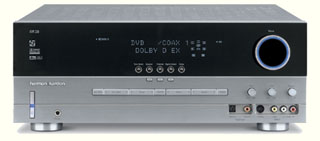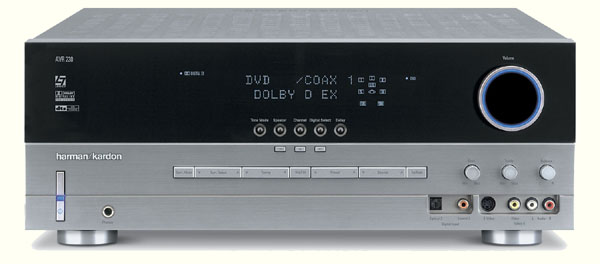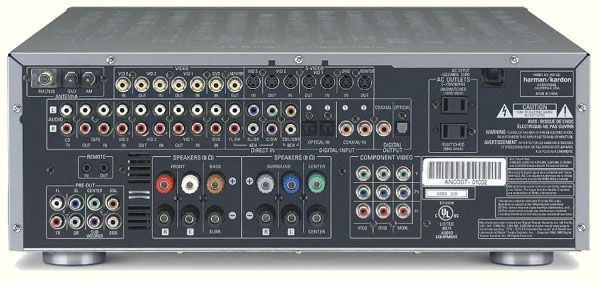Harman/Kardon AVR 230 7.1 Receiver
 |
|
Specifications: ● Codecs: DD, DD EX, DTS, DTS ES, DTS Neo:6, Logic 7 ● 6 amplifier channels, 50 Watts/Ch ● 7.1 Pre-Outs ● Dual Power Supplies ● 6 Digital Inputs ● 2 Digital Outputs ● 2 component video inputs ● Triple Crossover Bass Management ● EzSet Programmable Remote, With Macros ● Dimensions: 6 5/8" H x 17 5/16" W x 15" D ● Weight: 28 Pounds ● MSRP: $799 Harman/Kardon |
There are an awful lot of receivers available in the $500 - $600 range. This multitude of choices fuels the technology trickle-down. Bottom models of today now have features that were sought after in mid-priced receivers last year. Mind you, not all the features are really useful (such as some of the sound fields), and not all are found in every receiver. To add to the fun, most features are not set up properly by the average consumer (who happens to be the person to whom it is marketed).
I like features. More importantly I like the ability to customize the features and have them sound the best with my equipment, in my room. This is a one of my favorite points of the HK 230. You have the ability to alter how the remote functions, set up different calibration levels for each source, and even choose different crossover points for each speaker. In that regard, I loved this receiver. However, it does require a thorough reading of the instruction manual, something that most people just don't do.
This
review follows on the recently reviewed
AVR 630
so that you can see what you get for more or less money between the two
models.
Description
I have only once before had an HK product in my home. I was loaned an HK 120
while my own receiver was in the repair shop. That receiver didn't knock my
socks off, and if it wasn't for its awful looks, it would have been a
forgettable unit. Funny what a design change, and feature upgrade can do.
When I unpacked the
120, I was definitely impressed by the change in
appearance. Reading through the instruction manual, I became even more
interested. Packed inside this silver/black box was a whole lot of fun. It
may seem strange, but I actually enjoy reading user manuals and setting up
equipment. Unfortunately not everyone shares in my strange delights, and
this is important with the AVR 230.
The 230's front panel's display is large enough to view from my comfy couch, and
can be dimmed if needed. The large glowing volume control knob dominates the right
hand side of the unit, and a set of (very usable) buttons line the center.
When your remote is taken hostage by your significant other, you can still
configure the speakers! Unfortunately the labels for those buttons are near
impossible to read in anything but direct light.
The vast cornucopia of connections begins at the front. First off, there is
a
pair of digital inputs (3 optical and 3 coaxial), along with a set of analog
audio/video inputs (S-Video and composite video only). On to the back, we find 4
more digital audio inputs, 4 composite video inputs, 4 S-Video inputs, 3 component inputs, and
plenty of
audio inputs. There are also 7.1 pre-outs, 6 sets of speaker binding posts,
2 digital outputs, and a remote
loop. Two electrical outlets round out the
color-coded mosaic (HK's been pushing that for years) on the back.

Set-Up
Properly setting up your new AVR 230 is the single biggest factor on how well your
system will perform. Therefore, it is extremely important to read the
manual, and know exactly what you need to adjust, and how. Fortunately the
HK AVR 230's manual is well written, and helps to ensure that you get the
most out of this receiver. And read it you will need to do! (Is my message
about the instruction manual getting through?)
This receiver has more customizable features than any other I have tried in this price range. You can individually adjust the channel levels and bass management for every source. Well, not so much "can", more like "have to". Every source needs to be set up independently, as the settings are not copied over from one to the other. Speaking of bass management, this unit allows you to have different crossover points for front, center, and rear speakers. This is great for the ever-upgraded system.
One feature left out of the 230 is the internal test tones for subwoofer calibration. While I prefer to use warble tones and frequency sweeps to determine my subwoofer's optimum output level, it still would have been nice to have the test tones in this basic receiver.

Remotely Confused
Ah, the remote - one of the many often overlooked components of the home
theater system. I'd wager that more people would enjoy their home
theater more, with a better-designed remote.

There are a couple of key
things a remote needs to have to be usable while watching movies in the
dark:
1. Back lighting, or at least different shaped buttons.
2. Logically grouped buttons.
Sadly this remote has neither. It is a large remote jammed full of buttons,
yet it seems to be missing some essential ones, such as master volume
control (a pair of buttons that adjusts the overall volume). This
remote does, however, give you the option to program volume "punch-through".
This allows you to force the remote to use the receiver's volume when on
source TV.
On the bright side, there are four macro buttons, although they are hard to find. And, with a little practice, intelligent macros can be created.
This is a
welcome addition to any remote; think of the peace that can be obtained when
your wife picks up the remote and can watch TV with 1 button.
Another thing the 230 remote does have is a built in SPL meter. This is a long
overdue, and much needed feature. One problem. It must work well if it is to
work at all. Unfortunately, it does not work that well on this remote (see
below). My other
big nag about this remote is that it only takes one press to change sources. This
means that if want to turn your DVD player on while watching TV, you have to
be careful or you will change the source to DVD and (gasp!) interrupt that
all important show.
| Test 1 | Test 2 | Test 3 | Test 4 | |
| Front LT | 0 | +9 | -1 | -2 |
| Center | +1 | +10 | 0 | -1 |
| Front RT | -1 | +10 | 0 | -1 |
| Surround RT | -3 | 0 | 0 | 0 |
| Surround LT | -2 | 0 | 0 | -1 |
| Volume | 0 dB | -15 dB | 0 dB | 0 dB |
EZ Doesn't Do It
First thing I do with any new piece pf equipment is break out my Radio Shack
SPL meter and calibrate all the levels properly. To do this, I mount it on a tripod and place it at ear level on my couch. I then
get out of the room, and calibrate each speaker, referenced to the front
left speaker. Given the equipment I have, this is what I consider the most
accurate way to calibrate. The results are shown as Test 1 in the table on
the right.
To examine the HK AVR 230's EzSet auto-calibration function, I did a series of
tests, basing the results against my manual results. Test 2 was performed as
HK instructs in their manual, with the EzSet microphone in my hand, and the AVR
230's volume
at 15 dB. Tests 3 and 4 were in the identical position as the Radio Shack SPL
Meter.
Unfortunately, the results were not as accurate as they should have been.
However, this is a great feature that should work well down the road after
some fine
tuning of the programming code by HK.
In Use
Once I had the HK AVR 230 installed and set up, I immediately plopped in my
reference disc, Jesse Cook - Free Fall. This is a glorious album chock full
of percussive beats, detailed guitars, and deep bass. It brings out
every detail, and also can identify a lot of flaws. My first impression was
that it had a bit of bloated midrange. Not too much, but enough to be noticeable. On the
positive side, the modestly rated amplifier did not show any signs of stress
or weakness when driven to higher volumes. I proceeded to play the entire
disc (always a good sign) before I changed over to my other CDs.
Two other
CDs I use to evaluate equipment are Tom Waits - Rain Dogs, and Primus -
Pork
Soda. Those two, while far from mainstream, are both wonderfully intricate
recordings. The Tom Waits CD is loaded with bizarre instrument combos,
strange beats, and of course Tom Waits' raspy vocals. The Primus disc is what
I consider to be my best mid-bass test CD. Les Claypool uses everything from
6 string fretless bass to a cello! And I can't forget the kick drums
supplied by Herb Alexander, very revealing and wonderfully tight. With the
Tom Waits CD, the midrange bloat was not nearly as noticeable, and the
glorious imaging was defiantly intact. As well the Primus CD didn't fail to
deliver, especially with the dynamic "Mr Krinkle". This receiver defiantly
has more power that its ratings suggest.
For movies, the receiver did equally as well. However, I do believe that
the main difference between receivers in this price range is power, rather
than processing. And this unit has ample. My large, open room requires
modest power to achieve enjoyable dynamics, and the HK did surprisingly well
(considering the price and wattage). This unit is packed with most new
formats, from Dolby Digital EX to Logic 7. And, HK even was nice enough to
include two sets of rear surround speaker outputs.
Conclusions
One thing about reviewing equipment that I'll always have a hard time with
is returning the equipment. I'll be honest here, I am not in this for the
money. I like playing with stereo gear. So when it comes time to sending
equipment back, I usually have formed a strong opinion as to whether or not
I would want to use that piece again. That's the odd thing about the HK. I
wasn't blown away, but yet I was not disappointed. It has ample power,
globs of features, and my favorite . . . generous customization. Bottom
line, I didn't want to send it back.
- Jared Rachwalski -
Review System:
Speakers - Paradigm System 3
Receiver - Marantz sr5300
Source - Panasonic DVD-RV 32
Cables - Monster, Pro-link, Audioquest
Monitor Speaker Proscan RPTV

